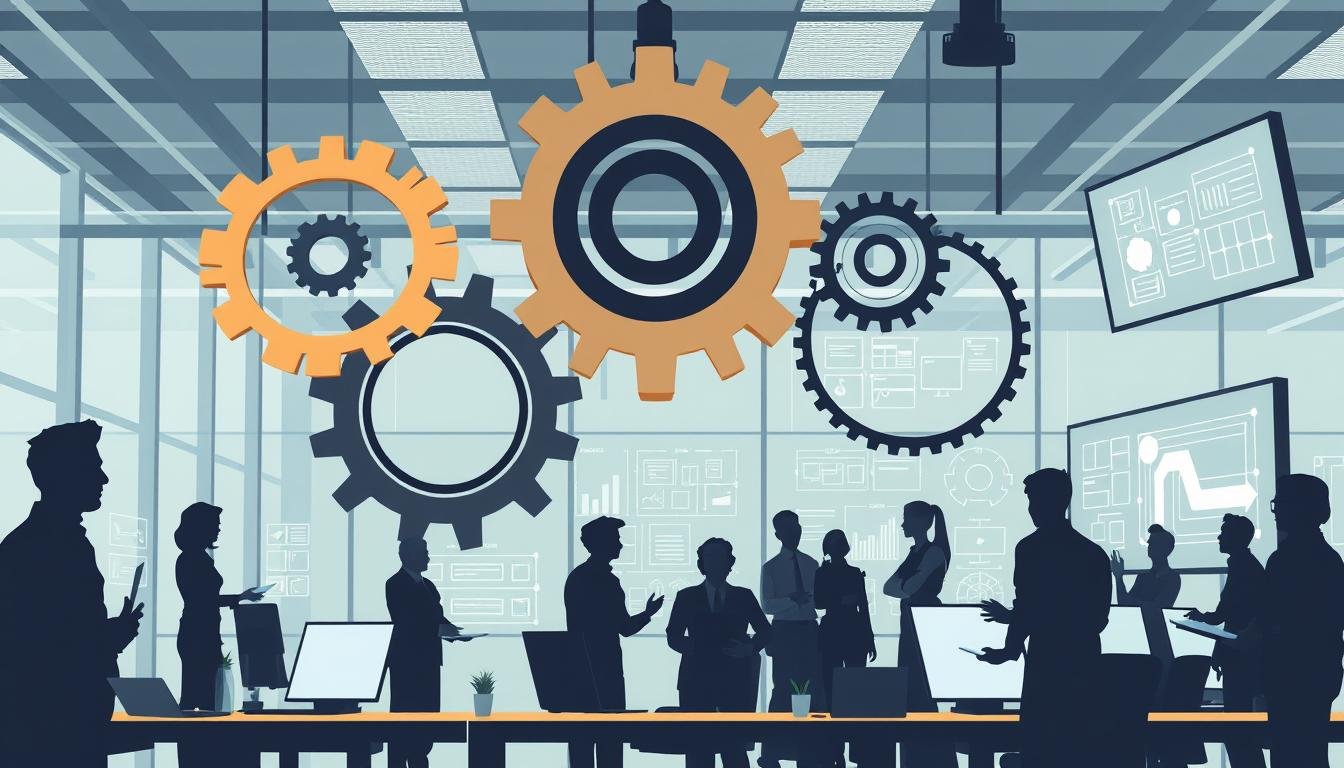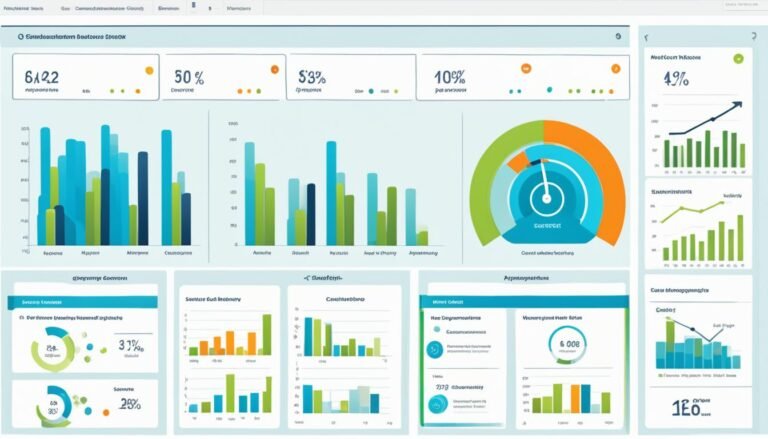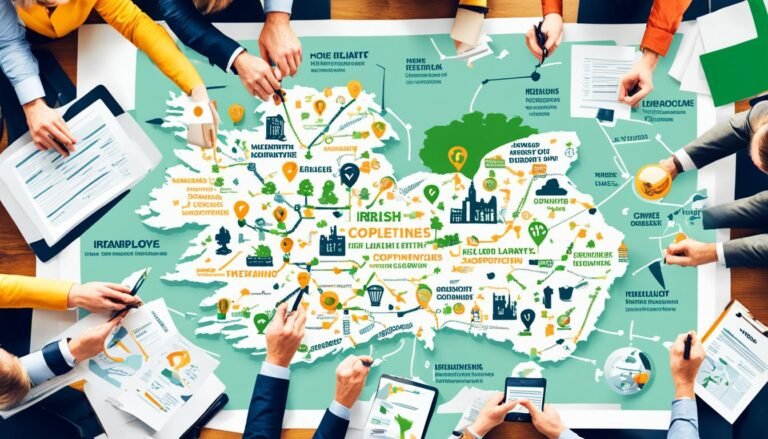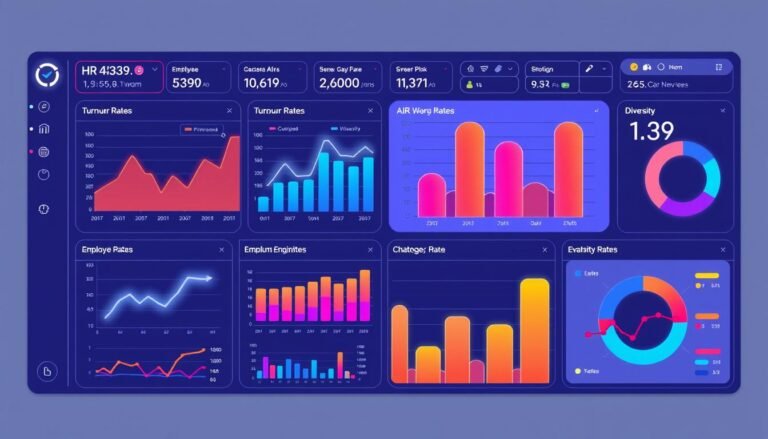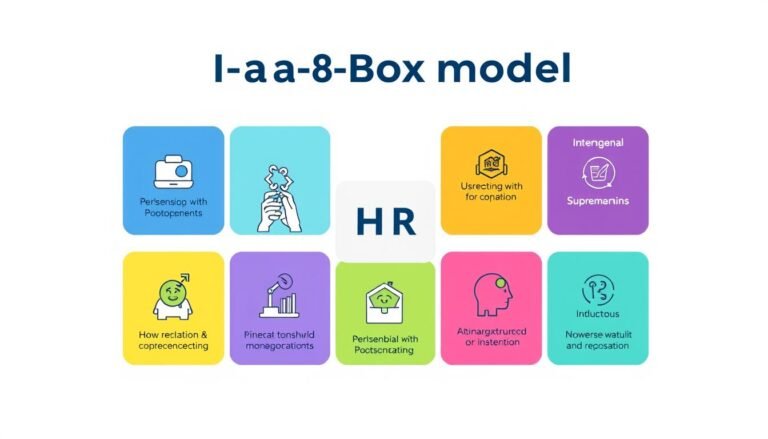Competency Frameworks for Modern Organizations
In today’s fast-paced business world, competency frameworks are key for managing talent and aligning organizations. They offer a clear path for employee performance and connect individual skills to company goals. This way, organizations can build a more focused and efficient workforce.
Competency frameworks bring many benefits to modern organizations. They make hiring easier by pinpointing the exact qualities needed in new hires. This ensures new employees fit their roles perfectly from the start. They also help in career growth by showing clear paths for advancement within the company.
When used right, competency frameworks boost employee performance. They give everyone a common language for talking about job expectations and tracking progress. This clarity helps managers and employees focus on what needs improvement and what deserves praise.
Key Takeaways
- Competency frameworks align individual skills with organizational goals
- They streamline recruitment and support career development
- Clear performance expectations improve employee productivity
- Frameworks should balance detail with flexibility
- Regular updates keep competency models relevant and effective
Understanding Competency Frameworks
Competency frameworks are key in today’s work world. They outline the skills and knowledge needed for the job. They help both employees and employers in developing skills and evaluating performance.
Definition of Competency Frameworks
A competency framework is a detailed model for success in roles or across an organization. It includes technical skills, behaviors, and foundational abilities. These frameworks usually have 12 competencies per role, focusing on important skills like communication and problem-solving.
Importance in Modern Organizations
In today’s fast-paced business world, competency frameworks are very important:
- Performance Improvement: Over 60% of companies see big improvements in employee performance with these frameworks.
- Employee Retention: Companies that match training with clear frameworks keep 50% more employees.
- Productivity Boost: IBM saw a 30% boost in productivity six months after using a framework.
- Strategic Alignment: Businesses that align frameworks with goals see 25% more employee engagement and 18% better performance.
These frameworks give a clear structure for mapping and developing skills. They help streamline recruitment, improve employee performance, and encourage learning. Companies using them are more likely to reach their goals and beat competitors.
The Benefits of Implementing Competency Frameworks
Competency frameworks bring big benefits to companies looking to improve their teams. They help in planning and assessing employees in a structured way. This leads to better management of human resources.
Enhanced Employee Performance
Companies that use competency assessments see a 25% rise in employee productivity. This is because employees know what’s expected of them and can focus on improving their skills. This clarity makes them happier and more engaged at work.
Streamlined Recruitment Processes
Competency frameworks make hiring easier by setting clear standards for evaluating candidates. Companies using these frameworks see a 19% drop in employee turnover. This is because they can find the right fit for each job more accurately.
Better Career Development
With competency frameworks, career growth becomes clearer. 72% of companies say it’s key to keeping employees. By outlining clear paths for advancement, companies help employees take control of their careers.
| Benefit | Impact |
|---|---|
| Productivity Increase | 25% |
| Turnover Reduction | 19% |
| Engagement Improvement | 20% |
These numbers show how competency frameworks help companies succeed. They lead to better performance, more efficient hiring, and stronger career paths for employees.
Key Components of a Competency Framework
A well-structured competency framework is key for effective Competency Mapping and Employee Assessments. It has three main parts that work together. Together, they form a complete Performance Evaluation system.
Skills and Knowledge Requirements
The base of any competency framework is the technical skills needed for certain roles. Today, about 80% of jobs need special technical skills. Companies spend nearly 30% of their training budgets on these skills, knowing they’re vital for doing the job well.
Behavioral Expectations
Soft skills and attitudes are also crucial for success. Research shows 75% of HR experts see behavioral traits as key to performance. Skills like communication, teamwork, and adaptability are key to a productive workplace.
Performance Indicators
Criteria for checking competencies help in fair measurement. These standards differ by industry and skill level. For example, the manufacturing sector has more novice employees, while tech has more skilled ones.
| Industry | Novice Level (%) | Proficient Level (%) | Expert Level (%) |
|---|---|---|---|
| Manufacturing | 40 | 45 | 15 |
| Technology | 20 | 60 | 20 |
| Healthcare | 25 | 50 | 25 |
By combining these parts, companies can see what it takes to succeed in different roles. This improves their Competency Mapping and Performance Evaluation.
How to Develop a Competency Framework
Creating a competency framework is key for planning your workforce and aligning your organization. It involves finding the essential skills and behaviors that lead to success in your company.
Steps to Identify Competencies
Competency mapping begins with knowing your business strategy. Here’s how to do it:
- Form a lead team
- Gather information through interviews and surveys
- Create the framework
- Define competency clusters and sub-clusters
The European e-Competence Framework, for example, lists 41 competencies for IT roles. It helps improve communication between HR and IT departments.
Involving Stakeholders in the Process
Getting stakeholders involved is crucial for a good competency framework. It’s important to involve staff and manage changes well. By including employees from different roles, you get different views and make sure everyone agrees.
| Competency Cluster | Sub-clusters |
|---|---|
| People | Communicating, Collaborating, Managing |
| Judgement and Decision Making | Using Data, Having a Long-Term View |
Your framework should be adaptable and updated often to stay current. With the right approach, it can greatly enhance hiring and lower turnover. In fact, 80% of employee turnover is caused by bad hiring, showing how vital competency mapping is in HR.
Customizing Competency Frameworks for Different Teams
Customizing competency frameworks is crucial for talent management and skill development. It’s important for organizations to adjust these frameworks for different teams. This ensures they are relevant and effective.
Tailoring for Technical Teams
For technical teams, frameworks highlight specialized skills and knowledge. This helps in career growth in tech roles. A good framework can boost employee performance by 40% and cut turnover by 50%.
- Emphasize technical proficiencies
- Include problem-solving skills
- Incorporate continuous learning competencies
Adapting for Leadership Roles
Leadership frameworks focus on strategic thinking and managing people. They are key for growing future leaders and improving the organization. Google’s Project Oxygen found that good management skills raised employee happiness by 25%.
| Leadership Competency | Impact on Organization |
|---|---|
| Strategic Thinking | 30% improvement in decision-making |
| People Management | 35% increase in team productivity |
| Change Management | 25% faster adaptation to new initiatives |
By tailoring competency frameworks, organizations can build a strong talent management plan. This plan supports employee growth at all levels and aligns with the organization’s goals.
Competency Frameworks and Employee Engagement
Competency frameworks are key to boosting Employee Engagement and improving Talent Management. They offer clear expectations and growth paths. This helps employees understand their roles and see how to grow.
Link Between Competency and Job Satisfaction
Research links competency frameworks to job satisfaction. For instance, Unilever saw a 15% boost in leadership ratings in 50 markets. This was due to a focus on adaptability and strategic thinking.
General Electric also saw a 20% jump in employee engagement. This was thanks to better leadership quality.
Fostering a Culture of Continuous Learning
Competency frameworks help in Capability Building by pinpointing areas for growth. They guide personal development plans. IBM, for example, boosted employee engagement by 20% and productivity by 10%.
“The opportunity to make a lateral career move was the most important predictor of employee retention—2.5 times more important than pay and 12 times more effective than offering a promotion.”
Companies that value innovation and adaptability include skills like creative thinking and problem-solving. This supports flexible career paths and encourages cross-functional mobility. It also allows for tailored career development plans, boosting employee engagement and retention.
Utilizing Competency Frameworks for Training Programs
Competency frameworks are key in creating effective training programs. They lay a strong base for skill and capability growth in companies. By using these frameworks, businesses can craft learning experiences that target specific skill gaps.
Designing Effective Training Initiatives
It’s vital to align training with both personal and company goals. Competency frameworks guide this alignment. They pinpoint essential skills and knowledge areas for improvement, leading to more focused training.
A good competency framework has five stages: Assess, Design, Develop, Implement, and Evaluate. This method ensures training is thorough and meets specific needs. For example, in the assessment phase, companies can check if employees have the right knowledge and skills through certifications.
Measuring Training Outcomes
Competency frameworks set clear standards for measuring improvement. This makes it easier to see how well training is working. It helps organizations track progress and use training resources wisely. Some ways to check if training is working include:
- Challenging written tests
- Case study evaluations
- Peer-review panels
Using these methods, companies can understand how well their training is doing. This helps them make smart choices for future training needs.
To get the most from competency-based training, companies should team up with experts. These partnerships bring in specialized knowledge for building skills, checking current abilities, and creating engaging courses. This is especially important for the 54% of millennials who prefer online learning.
Case Studies: Successful Implementation of Competency Frameworks
Real-world examples show how competency frameworks can change organizations. We’ll look at two companies that used these frameworks to improve their Talent Management and Organizational Alignment.
Company A: Transforming Performance with Competencies
IBM, a global tech leader, changed its Performance Evaluation with competency frameworks. Over three years, they saw big improvements:
- 20% better employee performance
- 15% less turnover
- 30% more employee engagement
These gains came from better talent management and aligning individual goals with company objectives.
Company B: Enhancing Recruitment Efficiency
Zappos, famous for its focus on customers, used competency frameworks to improve recruitment and customer service. The results were striking:
- 97% higher customer satisfaction
- Customer service reps were empowered with competency tools
- Skills in active listening and problem-solving improved
Zappos focused on competencies in hiring and training. This led to better Organizational Alignment and customer service.
| Company | Key Focus | Result |
|---|---|---|
| IBM | Performance Evaluation | 20% performance improvement |
| Zappos | Customer Service | 97% customer satisfaction increase |
These case studies show how competency frameworks can lead to big changes. They improve Talent Management and Performance Evaluation, driving success.
Challenges in Implementing Competency Frameworks
Organizations often face hurdles when rolling out competency frameworks. These challenges can impact Organizational Alignment, Workforce Planning, and Talent Management efforts. Let’s explore two key obstacles and their potential solutions.
Resistance from Employees
Employees may resist new competency frameworks due to fear of change or concerns about performance standards. A recent survey found that 70% of employees feel disconnected from their organization’s competency expectations. This misalignment can lead to disengagement and reduced productivity.
To address this issue:
- Involve employees in the framework development process
- Provide clear communication about the benefits and expectations
- Offer training and support to help employees adapt
Keeping Frameworks Up-to-Date
In today’s fast-paced business world, job roles and required skills evolve rapidly. Keeping competency frameworks current is crucial for effective Workforce Planning and Talent Management. Yet, 70% of organizations struggle to implement and maintain effective frameworks.
To ensure frameworks remain relevant:
- Conduct regular reviews and updates
- Gather feedback from employees and managers
- Stay informed about industry trends and emerging skills
| Challenge | Impact | Solution |
|---|---|---|
| Employee Resistance | 70% feel disconnected | Involve employees, communicate clearly |
| Outdated Frameworks | 70% struggle with implementation | Regular reviews, gather feedback |
By addressing these challenges, organizations can improve Organizational Alignment and enhance their Talent Management strategies. Companies that successfully implement competency frameworks see a 25% increase in employee performance. They are also 2.5 times more likely to outperform their peers in revenue growth.
The Future of Competency Frameworks in Organizations
As companies grow, competency frameworks will be key in planning and building their workforce. These frameworks are becoming more flexible and adaptable to the changing business world.
Trends Shaping the Next Generation Frameworks
One big change is the use of 360-degree assessments to fully understand employee skills. Tools like Vorecol 360 are leading the way in giving detailed feedback. This ensures a complete view of how well employees fit into the organization.
These new systems help spot areas where employees might be lacking. They also address the need for better frameworks in current models.
Integration with Technology and AI
Technology and AI are changing how we evaluate skills. New platforms give instant insights into what employees need to improve. This is key to aligning skills with company goals.
It makes training more engaging and helps in creating a cycle of continuous improvement. This is vital for better workforce planning.
In the future, competency frameworks will focus more on ongoing evaluation and growth. They will aim to be flexible and useful in many different situations. This change will help organizations better align and improve their workforce.
Source Links
- Competency Framework – Guide to Choosing a Framework | HRSG
- A 10 Step Guide to Creating a Relevant and Flexible Competency Framework
- Shift iQ | Online Assessment Platform
- The Role of Competency Frameworks in Workforce Development: Best Practices and Implementation
- Competency frameworks | Crowe Associates
- The Benefits of Competency Assessment in Modern Organizations
- Competency Management: Challenges and Benefits
- Why You Need a Competency Model for Organisational Development
- Competency framework: The Key Components of a Successful Competency Framework – FasterCapital
- How to Develop a Leadership Competency Framework: Step-by-Step Guide
- What Is Competency Mapping? Your Ultimate 2025 Guide
- Developing Your Competency Framework
- Grow Inclusivity and Performance with Competency Models
- Competency models vs. skills models: Full Guide | Gloat
- Best Practices for Developing Competency Assessment Frameworks for Diverse Workforces
- Engagement as a Competency – DecisionWise
- Competency Frameworks for Executive Development: Best Practices and Innovations
- Unlocking Flexibility: The Role of Competency Frameworks in Shaping Dynamic Career Paths – 3t
- Linking Competency Models to Modern Learning Strategies
- Workforce Compliance Training: How A Competency-Based Learning Framework Drives Performance And Skills Development
- Developing Competency-Based Training and Development Programs
- Successful Implementation of Competency Evaluation Tools in Different Industries
- Organizations that Successfully Transitioned to CompetencyBased Evaluations and the Lessons Learned"
- Beyond Competency Frameworks: Unleashing the Power of Dynamic Problem-Solving in the Workplace
- How to Align Competency Frameworks with Organizational Culture for Better Outcomes
- Competency Assessment Frameworks: Best Practices and Innovations
- Aligning Assessment with Organizational Goals
- A Six-Step Model for Developing Competency Frameworks in the Healthcare Professions

